Developing Emotional Regulation Skills In Autistic Teens
Understanding the Core Challenges
Emotional regulation difficulties are common in autistic teens, stemming from unique neurological and behavioral traits of Autism Spectrum Disorder (ASD). These challenges often manifest as tantrums, aggression, and self-injury, impacting their daily lives and development. By exploring the underlying factors and effective interventions, caregivers and professionals can better support autistic teens in managing their emotions more effectively.
The Nature of Emotional Regulation Difficulties in Autistic Teens

What are the core emotional regulation challenges in ASD?
Children and teens with Autism Spectrum Disorder (ASD) frequently experience disrupted emotional regulation (ER), which can manifest as tantrums, aggression, or self-injury. These behavioral disturbances often arise because managing and responding to emotions effectively is inherently difficult for many on the spectrum.
How do alexithymia and theory of mind deficits affect emotion regulation?
Two fundamental traits contributing to ER struggles in ASD are alexithymia—the difficulty in identifying and understanding one's own emotions—and impairments in theory of mind, which hinder perspective-taking. These core deficits limit emotional insight and make it challenging to process emotions accurately.
What is the impact of misinterpreting social and emotional cues?
Many autistic individuals tend to focus on irrelevant details or misread others' intentions. Such misinterpretations often heighten frustration, exacerbating difficulties in managing emotions and triggering behavioral outbursts.
How do impulsivity, inhibition deficits, and rigidity influence ER?
Impulsivity and poor inhibition mean that autistic teens might react before processing emotions fully. Additionally, rigidity in thinking limits flexibility, making it harder to adapt emotional responses to changing situations, thereby complicating regulation efforts.
What neural and physiological factors affect emotional regulation?
Differences in brain circuitry and physiological responses contribute significantly to ER challenges. Hypersensitivity to sensory input and tendencies toward hyper-arousal create heightened emotional reactions, impairing the individual's ability to remain calm and regulated.
These interconnected factors illustrate why emotional regulation presents a complex challenge for autistic teens, necessitating tailored support and interventions.
Recognizing and Assessing Emotional Regulation in Autism
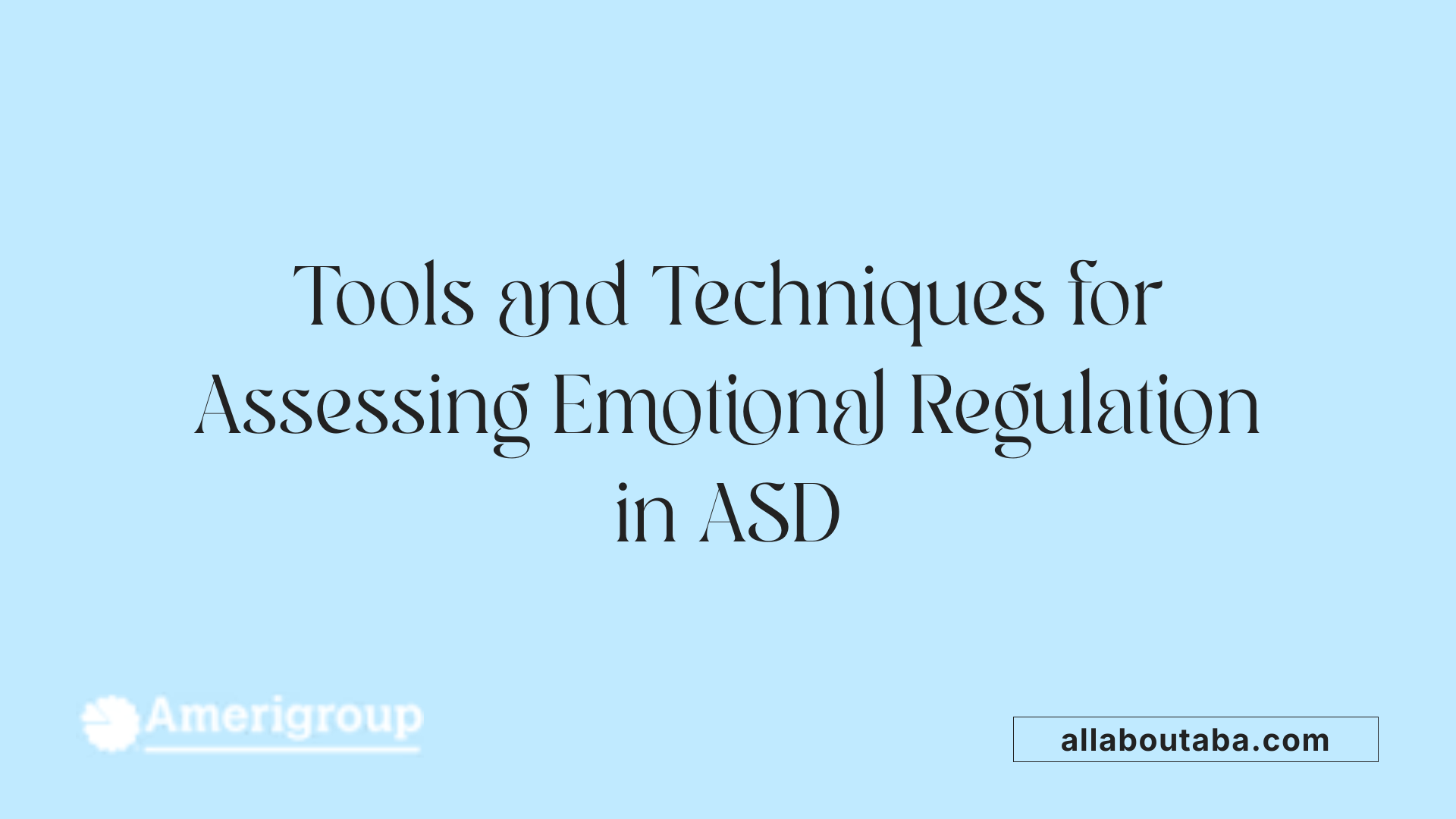
Challenges in assessing emotional regulation in ASD
Assessing emotional regulation (ER) in children with Autism Spectrum Disorder (ASD) is complex due to multiple factors. Communication difficulties often limit a child's ability to express emotional states clearly, making it harder to evaluate their regulation strategies. Additionally, medication use can alter emotional responses, sometimes dampening them, which further complicates reliable assessment. These challenges necessitate special considerations and methods tailored for the ASD population.
Usefulness of observational tools like the Incredible Five Point Scale
To overcome some assessment hurdles, observational tools such as the Incredible Five Point Scale have proven useful. This scale helps identify and teach emotional awareness by breaking down emotional intensity into manageable levels, making it easier for children with ASD to recognize and communicate their feelings. Such visual and structured tools provide clear guidance for both caregivers and therapists in understanding emotional states and responses.
Limitations posed by communication difficulties and medication effects
Despite these tools, significant limitations remain. Communication barriers can mean that even well-designed instruments might not capture the full emotional experience of a child with ASD. Moreover, medications often used to manage behavioral or neurological symptoms may blunt emotional expression or responsiveness, creating misleading signals during assessment. These factors demand careful interpretation of evaluation results with input from multidisciplinary teams familiar with ASD nuances.
Applied Behavior Analysis (ABA): Foundation of Behavioral Therapy in Autism

What is behavioral therapy in the context of autism?
Behavioral therapy for autism is primarily centered on Applied Behavior Analysis (ABA). This is an evidence-based approach rooted in behaviorism, designed to increase positive behaviors while decreasing harmful or disruptive ones. ABA uses reinforcement techniques to encourage helpful responses and is tailored to meet the unique needs of each child.
Role of ABA in shaping emotional regulation skills
ABA plays a critical role in teaching emotional regulation to children with autism. By understanding the triggers and consequences of specific behaviors, ABA strategies help children learn alternative coping skills and enhance their ability to manage emotions. Therapists use clear, structured steps to reinforce emotional awareness and self-regulation skills.
Individualized and structured intervention approaches
Interventions in ABA are highly individualized, focusing on the child's strengths, needs, and specific emotional challenges. Typical methods include routine-based, repetitive learning that provides predictability and structure, which many children with autism find supportive. Techniques like discrete trial training and pivotal response training are common, emphasizing both skill-building and behavior modification.
Research support and effectiveness of ABA
Research shows that ABA is effective in improving social communication and cognitive skills, which indirectly supports better emotional regulation. Yet, more high-quality studies are needed to establish definitive results on its efficacy specifically for emotional regulation. Safe ABA therapy involves personalized goals, balancing skill development with play and relaxation to promote wellbeing.
| Aspect | Description | Impact on Emotional Regulation |
|---|---|---|
| Definition | ABA is a behavior-based therapy tailored for autistic children | Supports learning adaptive behaviors and reducing distress |
| Role in ER | Helps identify triggers and reinforces appropriate responses | Teaches coping and self-regulation through structured steps |
| Intervention Style | Individualized, structured, routine-focused | Provides predictability and supports emotional stability |
| Research Evidence | Positive but requires more high-quality studies | Indicates promise in improving emotional and social skills |
Who Delivers Behavioral Therapy and How It Supports Emotional Growth
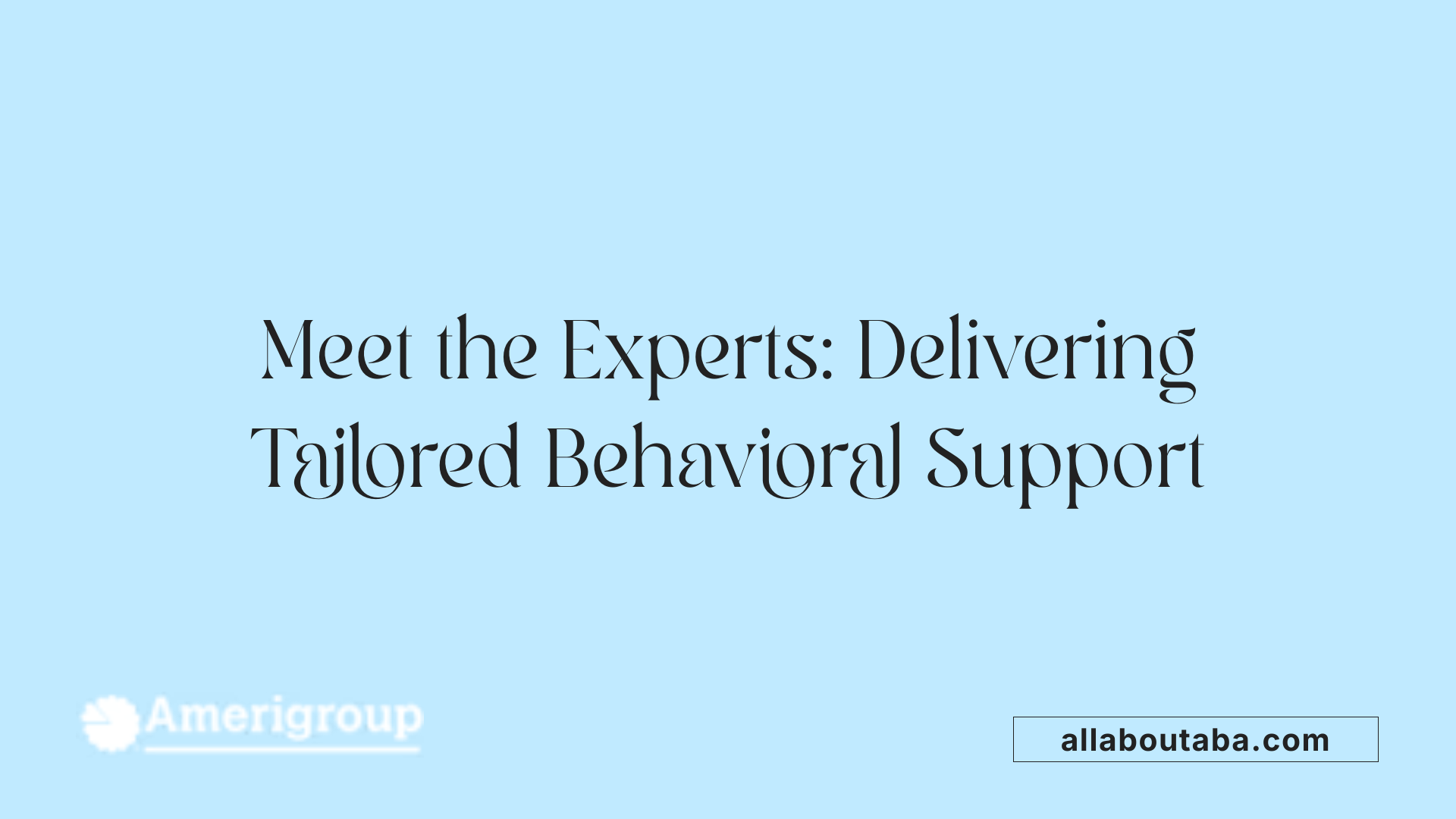
Who provides behavioral therapy services for individuals with autism?
Behavioral therapy for autistic teens is mainly provided by trained professionals with specialized knowledge in autism and Applied Behavior Analysis (ABA). Key providers include Board-Certified Behavior Analysts (BCBAs), who develop and oversee treatment plans, and Registered Behavior Technicians (RBTs), who directly implement therapy sessions. These therapists usually work alongside other specialists such as occupational therapists, speech therapists, and psychologists, forming multidisciplinary teams focused on holistic care.
What settings are used for delivering therapy?
Therapy can take place in various environments, including the child's home, clinics, and schools. Home-based therapy offers personalized support in a familiar setting, school-based therapy integrates learning within the educational environment, and clinic-based programs provide intensive intervention with structured resources.
Why is individualized programming important?
Individualized programming is crucial because each child with autism has unique strengths, challenges, and emotional regulation needs. Customized ABA programs target specific behaviors and skills, using reinforcement tailored to the individual. Regular monitoring and adjustments ensure that the therapeutic approaches remain effective and supportive of emotional and behavioral growth.
How does a multidisciplinary approach aid emotional regulation?
Combining behavioral therapy with occupational, speech, and psychological services allows for comprehensive strategies addressing emotional insight, communication, and impulse control. This collaborative approach enhances emotional regulation by targeting multiple skill areas necessary for adaptive behavior and social interaction.
Goals of Behavioral Therapy in Supporting Emotional Regulation

What goals does behavioral therapy aim to achieve for individuals with autism?
Behavioral therapy for children with autism focuses on improving communication and social skills essential for understanding and expressing emotions effectively. Enhancing these skills supports better emotional regulation by reducing misunderstandings that can lead to frustration and behavioral challenges.
A central goal is reducing challenging behaviors, such as tantrums or aggression, through reinforcement strategies that encourage positive behaviors and decrease negative ones. This is achieved by identifying triggers and teaching alternative, adaptive responses.
Developing adaptive routines and increasing emotional insight helps children anticipate and manage their feelings. Behavioral therapy breaks down broad objectives into smaller, manageable steps tailored to the individual’s needs, making progress more achievable and measurable.
Overall, the therapy aims to foster independence and improve quality of life by teaching self-regulation skills, promoting social engagement, and supporting emotional awareness using structured and personalized approaches.
Benefits of Behavioral Therapy on Emotional and Social Development

How does behavioral therapy benefit children and adults with autism?
Behavioral therapy, particularly Applied Behavior Analysis (ABA), supports children and adults with autism by enhancing essential skills critical for daily functioning. ABA focuses on improving communication, self-care, and social interaction through personalized, structured interventions.
Enhancing communication and self-care skills
ABA uses techniques like positive reinforcement to teach new skills through clear, routine-based steps. This approach encourages individuals to develop language abilities, learn self-care routines, and engage effectively with others. By targeting specific goals tailored to the child's strengths and needs, ABA promotes independence and confidence.
Reducing frustration and harmful behaviors
Many behavioral challenges in autism stem from difficulties in emotional regulation. ABA helps identify triggers and consequences of behaviors such as tantrums or aggression. By reinforcing alternative, more adaptive behaviors and using individualized strategies, ABA decreases frustration and harmful actions, contributing to better emotional control.
Supporting integration into social and community settings
Structured learning in ABA fosters social skills that enable participation in community activities, school, and peer interactions. This support helps individuals navigate social complexities and enhances their ability to function in diverse settings.
Long-term quality of life improvements through ABA
Early and consistent behavioral therapy contributes to meaningful progress in cognitive, language, and social domains. This ongoing development promotes a higher quality of life by increasing independence and adaptive functioning. While more research is needed for definitive conclusions, current evidence highlights the positive impact of ABA on lifelong outcomes for individuals with autism.
Practical Strategies to Foster Emotional Regulation Skills in Autistic Teens
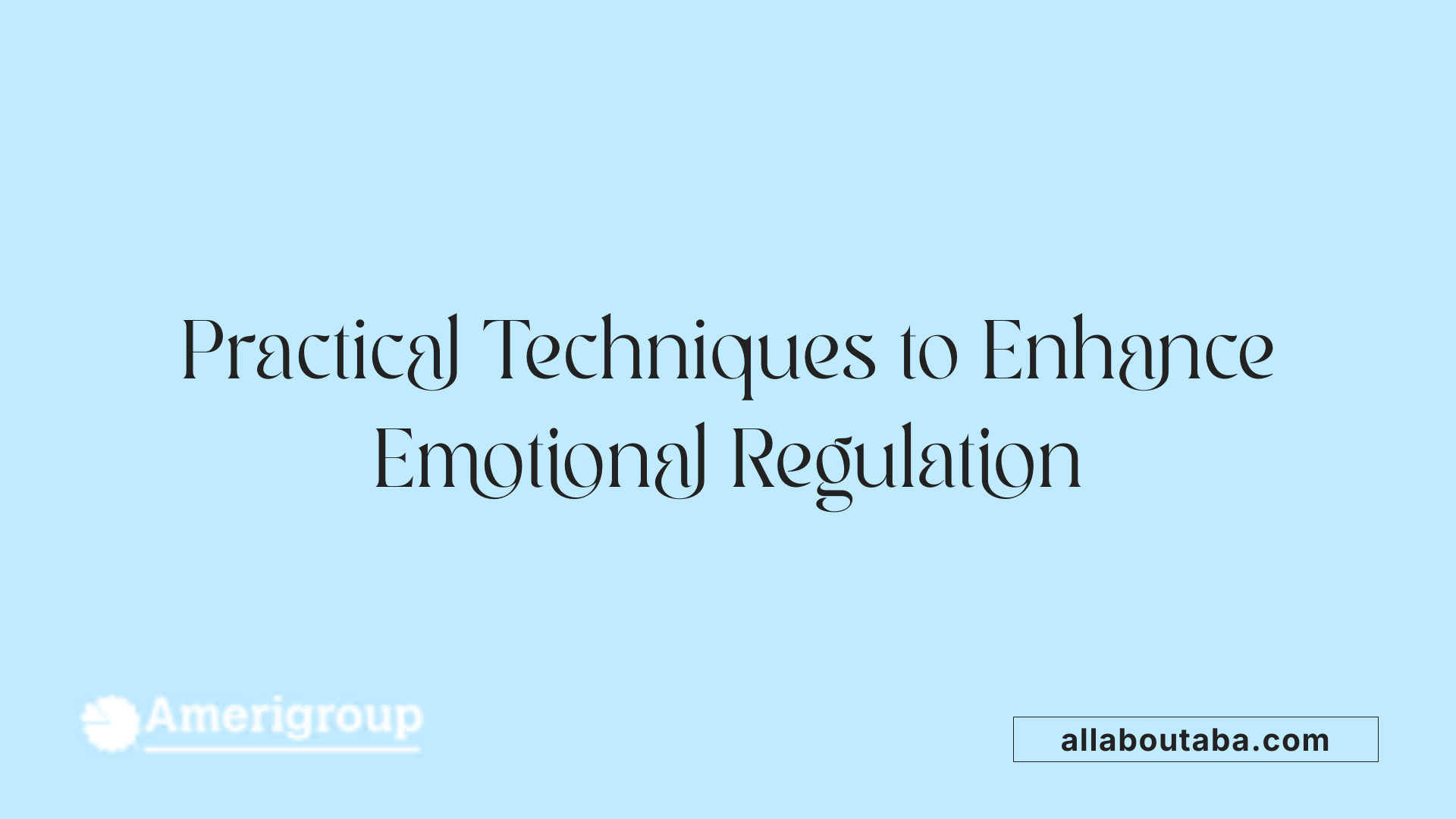
Teaching Recognition and Labeling of Emotions
Helping autistic teens recognize and name their emotions is a foundational step in improving emotional regulation. Children with autism may struggle with alexithymia, which makes identifying feelings challenging. Using structured teaching methods, parents and therapists can guide teens to better awareness of their emotions, aiding in managing reactions like tantrums or aggression.
Use of Visual Supports Like Emotion Charts and Zones of Regulation
Visual aids such as emotion charts and the Zones of Regulation system provide clear, accessible ways for teens to understand their feelings. Color-coded charts help classify emotions into categories, making it easier for autistic teens to recognize their emotional states. These tools support self-monitoring and signal when regulation strategies are needed.
Self-Soothing Techniques Including Deep Breathing and Sensory Items
Developing self-soothing skills is crucial for managing overwhelming emotions. Techniques such as deep breathing exercises—breathing in through the nose and out through the mouth—can reduce anxiety and restore calm. Additionally, sensory items tailored to individual needs, available in calm-down kits, offer tactile support to soothe heightened sensory sensitivity and hyper-arousal.
Developing Personalized Calming Toolkits and Predictable Routines
Personalized calming toolkits compile various strategies and sensory supports specific to the teen's preferences and environments. These toolkits might include favorite sensory objects, visual schedules, or calming activities. Establishing predictable daily routines further reduces stress and enhances regulation by providing structure and minimizing unexpected changes.
Guided Modeling and Practice by Parents and Caregivers
Parents and caregivers play a vital role by modeling appropriate emotional regulation behaviors and discussing suitable reactions with their teens. Through guided practice and positive reinforcement, they help teens internalize coping strategies. Creating calming spaces at home and planning for challenging public situations further supports emotional self-regulation.
| Strategy | Description | Benefits for Autistic Teens |
|---|---|---|
| Recognition and Labeling | Teaching emotions names and meanings | Enhances emotional awareness and control |
| Visual Supports | Emotion charts, zones of regulation | Facilitates self-monitoring and emotional insight |
| Self-Soothing Techniques | Deep breathing, sensory kits | Calms anxiety, manages sensory overload |
| Personalized Calming Toolkits | Customized tools and predictable routines | Provides personalized coping methods in various settings |
| Guided Modeling by Caregivers | Demonstrating and reinforcing healthy emotional responses | Encourages adaptive behaviors through social learning |
Emerging Therapies and Approaches to Support Emotional Regulation
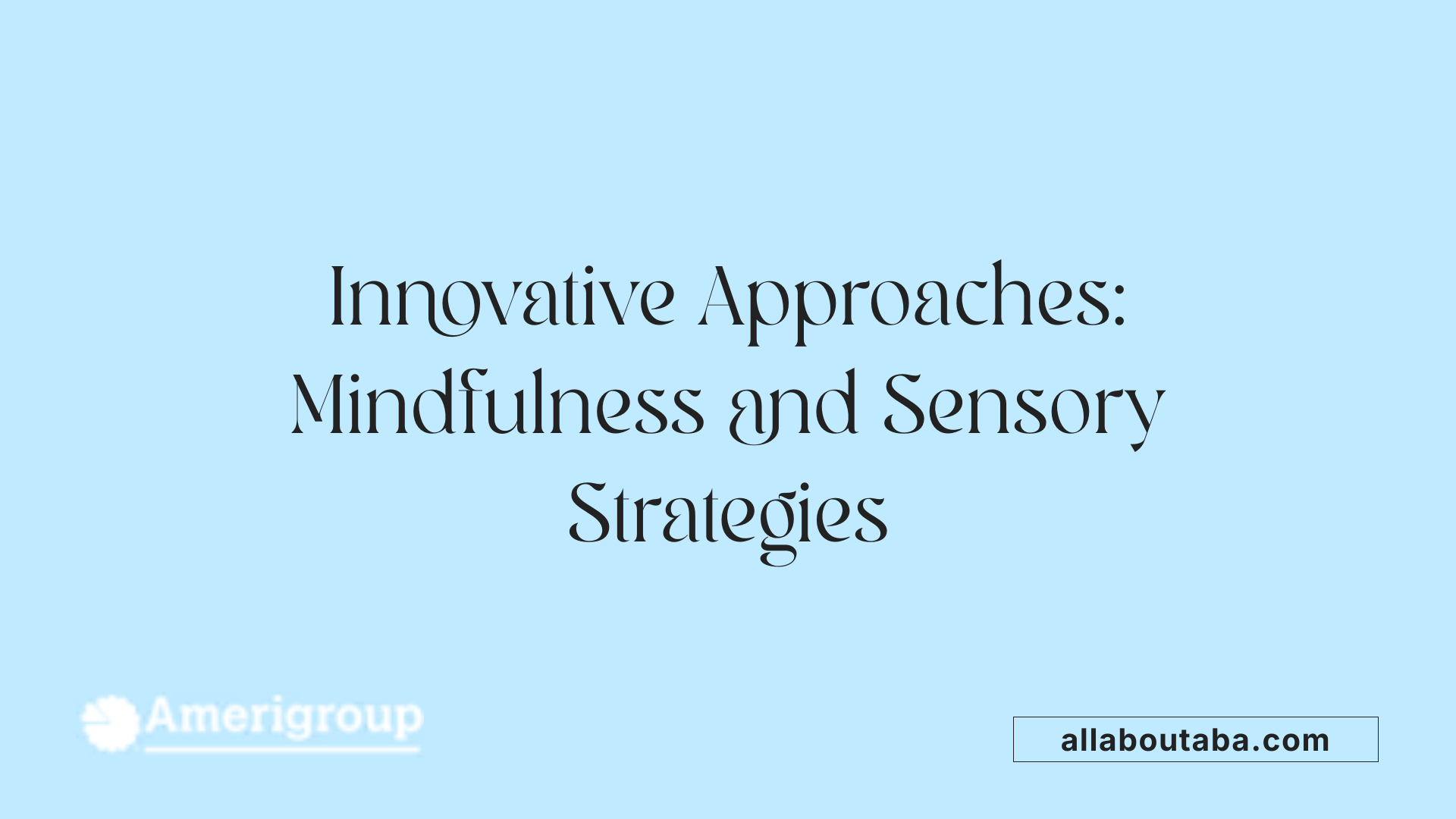
How are mindfulness and acceptance-based strategies used in supporting emotional regulation in ASD?
Mindfulness and acceptance-based therapies are gaining attention as promising approaches to improve emotional regulation in children with ASD. These strategies focus on increasing present-moment awareness and accepting emotions without judgment, which helps children better tolerate distressing feelings. Techniques such as guided meditation and breathing exercises allow children to build skills in noticing and naming emotions, reducing the intensity of emotional outbursts.
What role does psychoeducation play for parents and teens?
Psychoeducation is critical for empowering both parents and teens with ASD to understand emotional challenges and regulation techniques. Teaching families about how emotions work and providing practical tools encourages more effective support at home. Educated caregivers can model emotional regulation behaviours and create consistent routines, both of which help children feel more secure and manage emotions more successfully.
Why is addressing sensory sensitivities and physiological arousal important in ER for ASD?
Children with ASD often experience hypersensitivity to sensory input and heightened physiological arousal, which complicates emotional regulation. Approaches that recognize these factors—such as sensory-friendly environments and calming exercises like deep pressure or breathing—can reduce emotional overwhelm. Tailoring interventions to decrease sensory triggers plays a significant role in improving emotional stability.
What are the limitations and research needs related to ASD-specific ER interventions?
Although current therapies like cognitive-behavioral therapy have components addressing ER, tailored interventions specifically for ASD are limited. More validated assessment tools and outcome measures are needed to design effective treatments. Continued research is essential to refine these emerging therapies, evaluate their long-term impact, and develop personalized approaches that consider sensory and communicative differences unique to ASD.
Environmental and Lifestyle Factors in Supporting Emotional Well-being
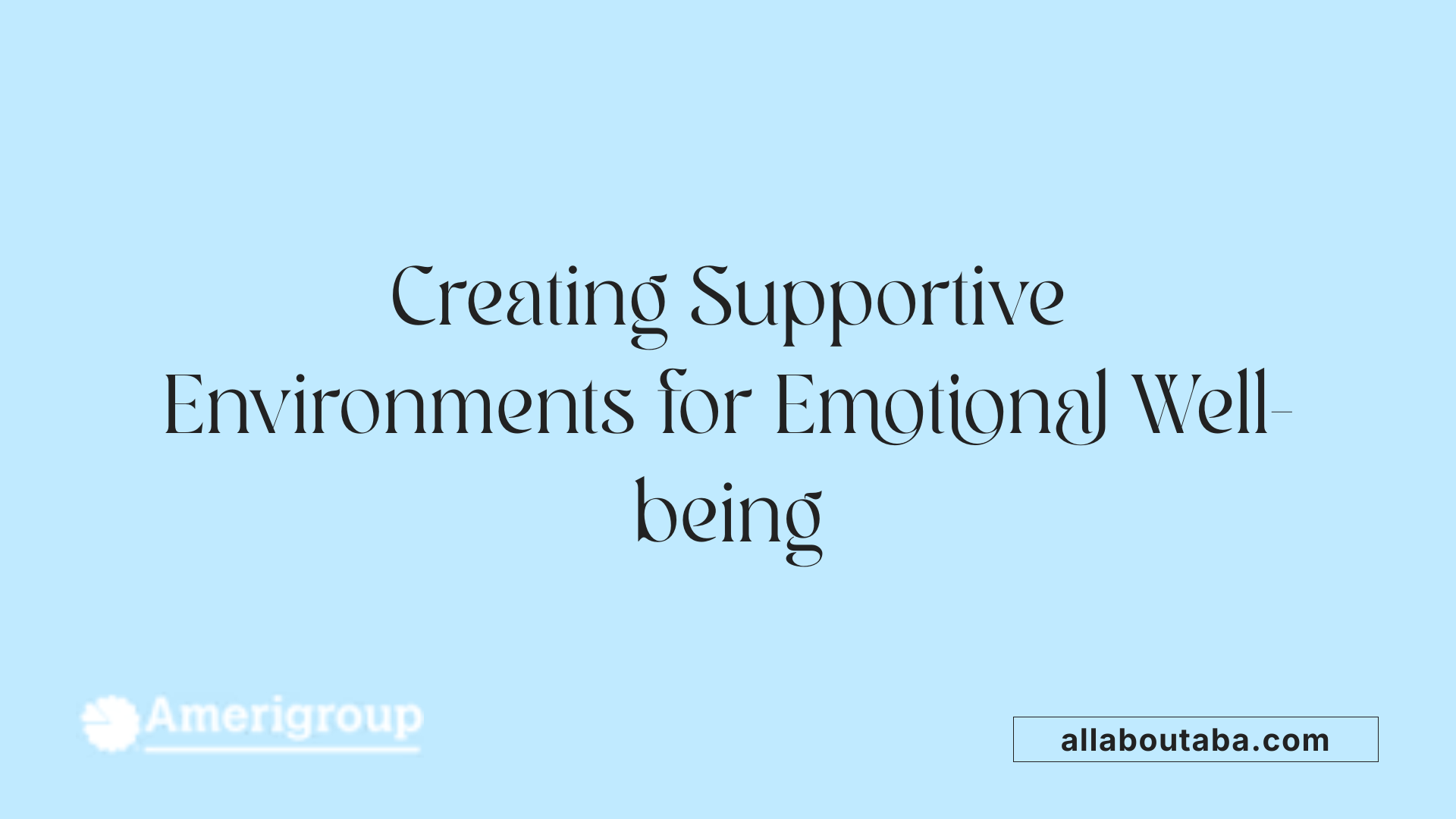
How do healthy lifestyle habits impact emotional regulation in children with autism?
Maintaining a healthy lifestyle plays a significant role in supporting emotional well-being for children with autism spectrum disorder (ASD). Good nutrition ensures that the brain and body receive essential nutrients needed for optimal function, which can influence mood and energy levels. Regular exercise helps children process emotions by improving physical health, reducing anxiety, and providing a constructive outlet for excess energy. Adequate sleep is equally important, as it supports cognitive functions and emotional stability, reducing the likelihood of dysregulation.
What is the benefit of creating calming spaces and planning for community outings?
Setting up calming spaces at home offers a predictable, safe environment where children with ASD can retreat when feeling overwhelmed. These spaces typically include sensory tools or soft lighting that promote relaxation and reduce sensory overload. Planning ahead for community outings helps manage expectations and reduce stress by preparing children for new environments and potential triggers. Having a clear plan increases comfort levels and supports better emotional regulation in public settings.
How can natural consequences and giving choices help children manage their emotions?
Using natural consequences helps children understand the outcomes of their actions, fostering greater emotional insight and responsibility. This approach supports learning from real-life experiences without the need for punitive measures. Offering children choices, such as selecting between activities or snacks, promotes a sense of control, which can alleviate frustration and improve emotional regulation. These strategies empower children by validating their preferences and encouraging self-management of emotions.
Why is balancing therapy, play, and relaxation important in emotional health?
A well-rounded approach to support emotional well-being includes structured therapy alongside periods of play and relaxation. Therapy, such as Applied Behaviour Analysis (ABA), focuses on developing meaningful emotional regulation skills tailored to individual needs. However, balancing this with playtime encourages creativity, stress relief, and social engagement. Adequate relaxation helps prevent burnout and sensory overload, making it easier for children to practice regulation strategies effectively. Together, these elements promote holistic emotional development and sustainable progress.
| Factor | Description | Benefits for Emotional Well-being |
|---|---|---|
| Nutrition | Consuming balanced meals with necessary nutrients | Supports brain function and mood regulation |
| Exercise | Involves regular physical activity tailored to preferences | Reduces anxiety and helps process emotions |
| Sleep | Ensuring consistent, restful sleep patterns | Enhances cognitive functioning and stability |
| Calming Spaces | Designated safe areas with sensory supports | Provides refuge and reduces sensory overload |
| Planned Community Outings | Structured preparation for outings to unfamiliar environments | Increases predictability and comfort |
| Natural Consequences | Allowing children to experience outcomes of actions | Promotes responsibility and emotional insight |
| Choice Making | Offering options within routines | Builds control and decreases frustration |
| Balanced Therapy & Play | Combining structured learning with leisure and relaxation | Encourages sustainable emotional growth and reduces burnout |
Building Lifelong Emotional Resilience
Developing emotional regulation skills in autistic teens is a multifaceted process requiring understanding of the unique challenges they face and access to tailored, evidence-based interventions. Behavioral therapy, particularly ABA, offers a well-researched foundation for supporting emotional growth by targeting behaviors and promoting adaptive skills. Complementing therapy with practical strategies, supportive environments, and healthy lifestyle practices further aids emotional resilience. Continued research and individualized care remain essential to empowering autistic teens with the tools they need to navigate their emotional world and thrive.
References
- Emotion Regulation: Concepts & Practice in Autism ...
- How To Teach Emotional Regulation In Autism | ART
- 25 Must-Try Techniques for Autism Emotional Regulation
- Applied Behaviour Analysis (ABA) and autistic children
- Applied Behavior Analysis (ABA)
- The Top 10 Reasons Children With Autism Deserve ABA
- 6 Benefits of ABA Therapy for Children with Autism
- Behavioral Therapy for Autism Spectrum Disorder in Children
Other articles
Recent articles

Cultural Perspectives On Autism Around The World

Autism And Creative Arts As Emotional Expression Tools

Developing Emotional Regulation Skills In Autistic Teens

Best Sensory-Friendly Lighting Solutions For Autism

Cognitive Behavioral Therapy Adaptations For Autism

Best Practices For Autism-Friendly Movie Screenings

Autism And Eating Challenges Beyond Picky Eating

Best Practices For Autism-Friendly Public Transport Design

Best Ways To Foster Collaboration Between Parents And Schools For Autism Support

Supporting Autistic Children During Transitions Between Activities

The Role Of Teachers In Fostering Autism Peer Acceptance

Using Art Therapy To Support Children With Autism

Autism And Strategies For Addressing Sensory Defensiveness

Autism And The Benefits Of Structured Leisure Activities

How To Support Autistic Students During Exam Season

Autism And Goal Setting For Personal Growth

How To Use Gamification In Autism Learning Programs

How Schools Can Reduce Bullying Of Autistic Students

Early Intervention Strategies For Autism Spectrum Disorder

The Role Of Therapists In Autism Life Skills Coaching

How To Support Autistic Individuals In Crisis Situations

Autism And Self-Care Routines For Stress Management

Understanding Echolalia And Its Role In Autism Communication

Autism And Fine Arts Education Benefits

The Impact Of Multisensory Learning On Autism Education

How Family Counseling Supports Autism Household Dynamics

Best Practices For Inclusive Playgrounds For Autism

Best Practices For Autism-Friendly Shopping Centers

How Autism Affects Fine Motor Skill Development

Best Ways To Introduce Sensory Activities Into Daily Routines

How Sports Teams Can Be Inclusive Of Autistic Players

Autism And Strategies For Building Workplace Resilience

Autism And The Impact Of Hormonal Changes During Puberty

How To Support Autistic Students In Foreign Language Classes

Best Ways To Teach Money Skills To Teens With Autism

Supporting Siblings Of Children With Autism

Autism And Co-Occurring Gastrointestinal Disorders

The Role Of Art Projects In Autism Sensory Integration

How Schools Can Incorporate Sensory Break Spaces

Best Practices For Autism Sensory Regulation At School

Autism And Strategies For Teaching Organizational Skills

Understanding The Relationship Between Autism And Anxiety Disorders

Autism And Life Planning For Long-Term Care

Exploring Visual Supports In Autism Education

Ways To Encourage Social Interaction In Children With Autism

The Connection Between Autism And Dyscalculia

The Role Of Occupational Therapy In Transition Planning For Autism

The Role Of Physical Therapists In Autism Motor Skills Support

How To Teach Decision-Making Skills To Autistic Young Adults

The Connection Between Autism And Epilepsy

Best Practices For Transitioning Autistic Children Into New Schools

Autism And Time Management Challenges In Adulthood

The Role Of Visual Arts In Autism Communication Development

How To Address Tactile Defensiveness In Autism

Best Practices For Telehealth Autism Therapy

How To Help Autistic Children Develop Friendship Skills

How Schools Can Support Autistic Students In Career Prep

Best Strategies For Autism-Friendly Event Planning

Understanding Noncontingent Reinforcement In Autism Behavior Plans

How Drama Therapy Benefits Autistic Individuals

Best Practices For Autism-Friendly Fitness And Recreation Centers

Best Ways To Promote Healthy Social Media Use For Autistic Teens

How To Help Autistic Children Cope With Public Speaking

Autism And Strategies For Managing Unexpected Changes

Best Podcasts About Autism For Parents And Educators

Autism And The Impact Of Seasonal Changes On Behavior

The Role Of Diet In Managing Co-Occurring Conditions With Autism

Sleep Challenges In Autism And Practical Solutions

Best Ways To Build Daily Routines For Autistic Children

Best Practices For Supporting Autistic Entrepreneurs

Autism And Strategies For Navigating Large Social Gatherings

Adaptive Sports And Recreational Activities For People With Autism

Autism And The Benefits Of Story-Based Learning Activities

Understanding The Role Of Play In Autism Development

Autism And The Impact Of Environmental Noise On Learning

How To Create Autism-Friendly Community Spaces

Autism And Chronic Health Conditions: What To Know

The Role Of Care Managers In Autism Life Planning

How To Teach Social Boundaries To Autistic Children

How Autistic Individuals Experience Empathy Differently

How To Support Autistic Employees In Remote Work Settings

Autism And The Relationship Between Motor Skills And Learning

How To Create Community Resource Guides For Autism Families

How To Teach Daily Living Skills To Autistic Teens

Autism And The Impact Of Mind-Body Practices On Stress Reduction

Autism And The Benefits Of Outdoor Group Activities

How To Create Autism-Friendly Sensory Paths In Schools

Best Practices For Autism-Friendly Park And Recreation Areas

Autism And Strategies For Reducing School Refusal

Supporting Autistic Individuals In Public Speaking

The Role Of Diet In Managing Autism Symptoms

The Benefits Of Gardening Clubs For Autism Social Development

How To Prepare Autistic Children For Dental Visits

Autism And Employment: Career Paths That Work

Best Practices For Autism-Friendly Hotels And Lodging

The Impact Of Screen Time On Autism Development

Autism Screening Tools For Early Childhood

The Role Of Physical Exercise In Autism Therapy

Best Strategies For Supporting Autistic College Students

The Role Of Technology In Autism Early Detection
We’re All About You, Your Family, and Your Child

